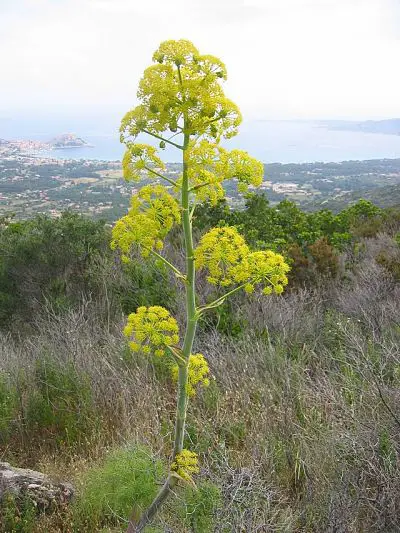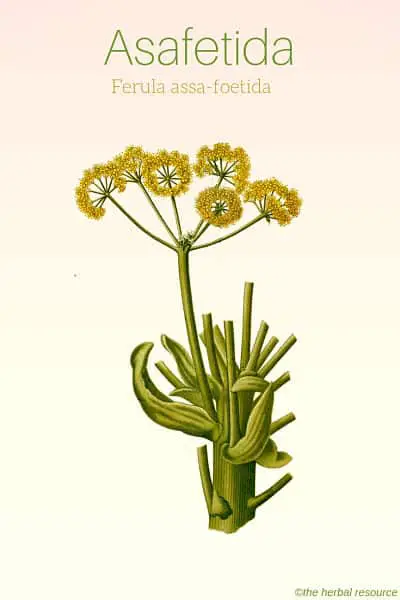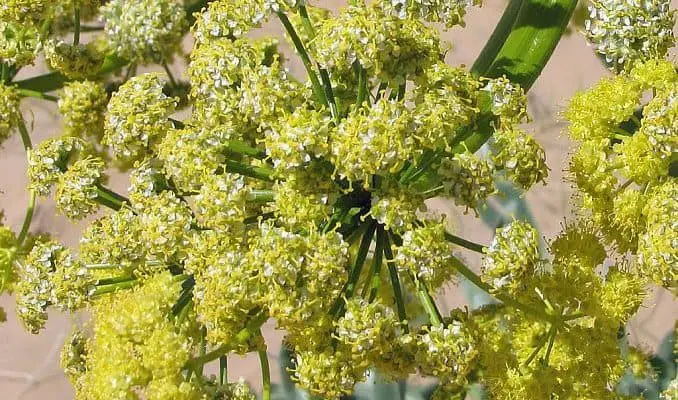Botanical Name: Ferula assa-foetida.
The scientific species name assa-foetida is composed of the Persian word aza meaning “resin” and the Latin word foetidus meaning “smelly” referring to the plant’s rather strong and unpleasant odor.
At the time of the Roman Empire asafetida was a popular seasoning and the Romans referred to it as “food of the gods.” For centuries the plant was imported from countries around the Persian Gulf to Europe.
In the Middle Ages, asafetida was used both as spice and medicine across Europe, but towards the end of the 16 century, its uses slowly ceased to exist. Today, this aromatic plant is little more than a memory in the Western world.
Traditional Uses of Asafetida
Asafetida is said to be endowed with magical powers and thought to ward off evil spirits. It was believed that the strong pungent smell of the plant could keep certain diseases at bay. For that reason, it was a practice in some European countries for children to keep small cloth bags containing the herb close to their chest, as an amulet to protect them against infectious diseases, especially colds.
In Chinese herbal medicine, asafetida has been used since 600 AD mainly as a nerve stimulant in the treatment of neurasthenia (nerve weakness). The herb is also widely used in traditional Indian medicine (Ayurveda) as a brain stimulating herb.
In East Asia, the resin has been used as herbal medicine for centuries as an expectorant and diuretic. There it is also used against intestinal worms, convulsions, and hysteria. In Iran, the herb has a reputation as an aphrodisiac. 1
Current Medicinal Uses of Asafetida
Most of the medicinal application of asafetida is based on traditional and folk uses, and not many scientific studies have been done on the plant’s health benefits and therapeutic properties.
When asafetida is intended as an internal remedy, it is often used in conjunction with other herbs. Internal uses include treatments for inflammation and spasm conditions in the digestive tract, colic due to intestinal gas, belching and cramps.
The essential oil extracted from asafetida has, in the same manner as garlic, expectorant properties. The herb is therefore often used to treat bronchitis, bronchial asthma, whooping cough, and other respiratory ailments.
Two double-blind trials have been done on the herb in homeopathic form as a treatment for irritable bowel syndrome where it was reported that the plant had a significant positive effect. 2 3
There are reports that suggest that the herb also has an antihypertensive effect and could be used to lower blood pressure naturally. 4
Additionally, the herb may be used to reduce cholesterol and regulate blood sugar. 56
Active Substances and Constituents
The complex rubber resin of asafetida consists of many substances which can vary widely, depending on which species of the genus Ferula are used in its manufacture.
Resins from Ferula assa-foetida contain 40-60% resin, 25% rubber (composed of polymers of glucose, galactose, L-arabinose, rhamnose, and glucuronic acid), 6-17% essential oil and coumarins.
Plant Parts Used
It is mainly the oily gum resins containing the essential oil that is used both as food and medicine. This resin is extracted from four to five-year-old plants that have not bloomed.
The essential oil is extracted from the resin by steam distillation. The oil is yellow-orange and has a bitter, pungent taste and a powerful scent reminiscent of garlic.
The aerial parts (stems, leaves and immature flowers) can be used as a vegetable.
Dosage and Administration
The following dosage has been recommended when the plant is intended for medicinal use.
- Powdered resin: 0.3-1 grams – three times daily.
- Emulsion: 4 parts powdered resin to 100 parts water.
- As infusion or tea: 1-2 cups daily.
- Commercial pills or capsules: Follow the manufacturer’s instructions.
- Tincture: ½ – 1 teaspoon daily.
Side Effects and Warnings
Asafetida should not be used during pregnancy because it may act as an abortifacient and it should not be given to infants or young children.
There have been no reports of side effects when the herb is used in recommended doses as medicine. On the other hand, too much of the herb can cause swelling of the lips, indigestion, burping, flatulence, diarrhea, nausea, vomiting and a burning sensation in the digestive tract, burning urination, dizziness, and headache.
Used externally, asafetida may cause skin rash in people who are sensitive to plants in the Apiaceae family.
Other Common Names
- Asafoetida
- Assafoetida
- Asant
- Stinking gum
- Persian assafoetida
- Devil’s dung
- Food of the gods
- Giant fennel
- Dyvelsdræk (Danish)
- Teufelsdreck (German)
- A-wei (Chinese)
Habitat
Asafetida is endemic to Afghanistan, Pakistan and eastern Iran where it is also cultivated commercially.
Plant Description
Asafetida is a perennial belonging to a group of plants commonly known as the celery, carrot or parsley family (Apiaceae). The plant, which can grow up to two meters in height, has a robust rhizome and large finely divided green leaves.
Asafetida usually blooms when it is five years old. The flowers are small and yellow sitting in compact floral displays on thick, hollow stalks. The plant is self-fertilizing and has both male and female flowers that are pollinated by insects. After flowering the plant withers and dies.
Supporting References
Atkins, Rosie, et al.: Herbs. The Essential Guide for a Modern World. London, Rodale International Ltd. 2006.
Augustine Amalraj, Sreeraj Gopi: Biological activities and medicinal properties of Asafoetida: A review,
Journal of Traditional and Complementary Medicine, Volume 7, Issue 3, 2017, Pages 347-359, ISSN 2225-4110.
Bown, Deni: The Royal Horticultural Society New Encyclopedia of Herbs & Their Uses. London, Dorling Kindersley 2002.
Breverton, Terry: Brevertons Complete Herbal. A book of remarkable plants and their uses. London, Quercus Publishing Plc 2011.
Gardner, Zoë & Michael McGuffin (editors): American Herbal Products Association’s Botanical Safety Handbook, Second Edition. Boca Raton, FL, CRC Press 2013.
Gruenwald, Joerg, et al.: PDR for Herbal Medicines. Fourth Edition. Montvale, New Jersey, Thomson Healthcare Inc. 2007.
www.pfaf.org
Lawless, Julia: The Illustrated Encyclopedia of Essential Oils. Shaftesbury, Element Books 1995.
Pharmaceutical Press Editorial: Herbal Medicine, Fourth Edition. London, Pharmaceutical Press 2013.
Rayburn, Debra J.: Let’s Get Natural with Herbs. Huntsville, AR 72740, Ozark Mountain Publishing 2007.
Syeda, Sarah & Abbas, Syeda & Naveed, Dr.Safila & Qamar, Fatima & , Saba & Hussain, Javed & Jawed, Syed. (2015). EXPLORATION & WONDERS OF MEDICINALPLANT ” ASAFOETIDA “. International Educatinal Scientific Research Journal. 3.
Skenderi, Gazmend: Herbal Vade Mecum. 800 Herbs, Spices, Essential Oils, Lipids Etc. Constituents, Properties, Uses, and Caution. Rutherford, New Jersey, Herbacy Press 2003.
Williamson, Elisabeth M.: Potter’s Herbal Cyclopaedia. Essex, Saffron Walden 2003.
Thordur Sturluson
Latest posts by Thordur Sturluson (see all)
- What is the Difference Between Hemp and Marijuana? - June 3, 2019



Hi asafetida cured My daughter convolution this is A herb I used daily in My home All My Life I’ve been wondering how asafetida was made little did I know that this herb came A tree with beautiful yellow flowers thanks I dearly appreciate this information